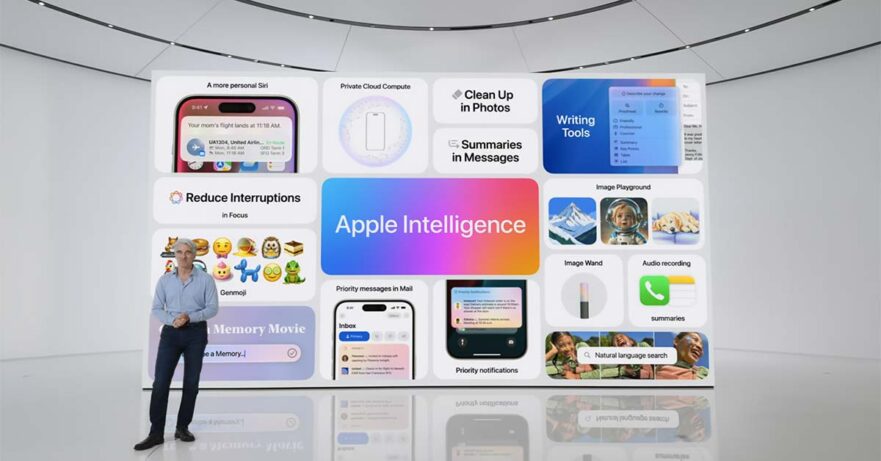Apple finally pulled the curtains back on its long-awaited artificial-intelligence strategy at its annual Worldwide Developers Conference in Cupertino, California, kicking off a new era for the technology giant with the introduction of generative AI features for the iPhone, iPad, and Mac.
Apple is calling its brand-new AI platform Apple Intelligence, and it’s coming later this year. Here’s our roundup of five important things you need to know about it.
ChatGPT under the hood — but the door’s open for Gemini and other third-party AI platforms
The first thing you should know about Apple Intelligence is that it’s powered by ChatGPT — for now, at least. But Apple isn’t a one-horse town.
The company says it intends to support other third-party AI models in the future, with Google’s Gemini being named as one of its potential partners. With its partnership with OpenAI, Apple is offering basic access to ChatGPT features within Apple Intelligence for free, without needing an OpenAI account or paying for premium services, though its integration with supported devices is limited and requires users to actually opt in.
Apple Intelligence won’t work on all devices, for privacy and security reasons
So, when is Apple Intelligence coming to your device? The company says its new AI features will be exclusive to iPhone 15 Pro and Pro Max models, which run on an A17 Pro chipset, as well as iPads and Macs with M1 chips or newer, and devices set to the English language. This could leave a significant portion of the Apple user base behind, at least initially. The features will start rolling out this fall in iOS 18, iPadOS 18, and macOS Sequoia.
Okay, so it’s not coming to all Apple devices, but it’s also important to note that Apple Intelligence will prioritize on-device processing for enhanced privacy while also relying on cloud-based AI processing for complex or computationally heavy tasks. Apple says many of its new AI features will run entirely on your device without uploading any data to the cloud.
During the WWDC 2024 keynote, Apple senior vice president for software engineering Craig Federighi said the company strongly emphasized consumer privacy when it announced Apple Intelligence, adding that its “architecture is built with privacy at the core.”
Apple Intelligence leans on a new system called Private Cloud Compute. This cloud-based setup utilizes beefier server-side models built on Apple’s custom silicon. The key here is that user data never actually gets uploaded to the cloud. Instead, the data is processed on the device itself, with only the anonymized request sent to the server for computation. This approach allows Apple to offer the benefits of cloud-based AI horsepower without compromising user privacy — a win-win for users and Apple.
A flood of new AI features coming to Apple devices
Apple Intelligence will bring a wave of AI-powered features to iPhones, iPads, and Macs. Here’s a taste of what you can expect:
- Photos on steroids. Say goodbye to pesky photobombers and unwanted objects in your photos. Apple Intelligence brings AI-powered object removal to the Photos app, letting you clean up your shots with just a few taps.
- AI-generated emojis. Forget smiley faces and thumbs up. Apple Intelligence lets you create custom emojis — or, as Apple calls it, Genmoji — based on text descriptions, and that includes emojis that look like real people! Simply provide a text prompt, and Apple Intelligence will whip up a personalized emoji for iMessages.
- TL;DR for everything. Information overload? No worries. Apple Intelligence can generate quick summaries of your notes, texts, emails, and other content, letting you grasp the gist in seconds.
- AI-powered inbox. Apple’s Mail app is getting a major AI upgrade, too. It can automatically categorize your emails and even instantly generate responses to emails in the inbox. Think of it as your own personal email butler.
- Note-taking to the next level. Voice memos are about to get a whole lot more useful. Apple Intelligence can automatically transcribe your recordings, making it easier to revisit those important voice notes.
- Scribble math problems and let AI answer them. The Calculator app is finally coming to the iPad with the new Math Notes feature. This allows you to write out mathematical expressions with your Apple Pencil and see them instantly solved in your own handwriting. Impressive! Plus, your Math Notes are automatically saved in the Notes app, keeping your work organized and accessible.
These are just a few highlights, and there’s more to come. iOS 18 also boasts customizable icons and a visual refresh for Control Center, Settings, and Messages. Apple is even launching a dedicated Passwords app to manage your login credentials. Now, we see some apps that we use redundant.
Video showcasing Apple Intelligence in 5 minutes
Siri’s getting an AI makeover
Of course, Siri is getting an Apple Intelligence boost as well. Apple’s virtual assistant has a new look and a new list of features for users. Siri will be able to understand and respond in a more natural way, making conversations feel less robotic. And it will be able to handle follow-up questions with context and leverage information from your device, like emails, photos, and messages.
Imagine Siri pulling up data from your inbox to give you the address of where your next meeting will take place, or referencing a birthday photo to wish your friend a happy birthday with a personalized Genmoji.
Ultimately, it’s still about iPhones
One thing became abundantly clear during WWDC 2024: Apple isn’t aiming for a subscription-based AI service like ChatGPT or Gemini. Apple Intelligence isn’t a separate product to be marketed and sold; it’s an integrated feature designed to make Apple’s cash cow, the iPhone, even more appealing to consumers.
Instead of reinventing the wheel, Apple, the tech giant with a trillion-dollar war chest, smartly opted to collaborate with OpenAI, the creators of ChatGPT, to launch its initial AI features. This is a strategic move on both financial and growth fronts. Why build everything yourself when you can leverage established third-party models as plugins for your own AI platform? That’s essentially what’s happening here.
This approach allows for easy integration of future AI models that surpass ChatGPT. And who knows? If Apple Intelligence matures and reaches a high level of quality, Apple might eventually phase out third-party models altogether. But for now, the focus is clear: supercharge the iPhone (and other Apple products) with the power of AI.
Share this Post




